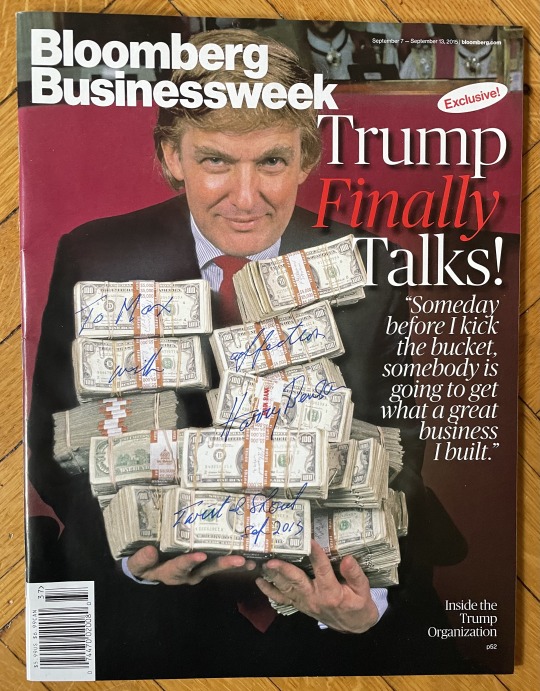#businessweek
Text


Did an illustration for Bloomberg Businessweek, the article talks about American labor unions recruiting and training volunteers to work undercover in Starbucks, Amazon and other companies. I parodied Magritte's painting Golconda.
Thanks to AD Albert.
#illustration#illuatrator#illustrations#art#Magritte#BloombergBusinessweek#businessweek#unions#starbucks#amazon#chipotle
241 notes
·
View notes
Text

Illustration for Bloomberg, 2021
60 notes
·
View notes
Text
MFABoston's Romance With NFTs: Not Fiscally Tangible, Maybe?
MFABoston’s Romance With NFTs: Not Fiscally Tangible, Maybe?
The other day the hardworking staff received this email from Boston’s Museum of Fine Arts.
Not to get technical about it, but we don’t have a digital collection of NFTs, mostly because they’re the pet rocks of the art world.
But we’re getting ahead of ourselves.
Last year the Boston Globe’s Malcolm Gay reported on the origins of the MFA’s NFT fling.
���Someone had to move first’: MFA plans sale…

View On WordPress
#(Bit)coin flip#19th century French pastels#Bloomberg#Boston Globe#Brendor Grosvenor#British Museum#Businessweek#Diary of an art historian#Edgar Degas#Hokusai#J.M.W. Turner#laCollection#Malcolm Gay#Matt Levine#MFA NFT fling#MFABoston#Terry Sullivan#The Art Newspaper#vapor-art#Yahoo
3 notes
·
View notes
Text
For Multinationals, Africa’s Allure Is Fading
Nestlé SA in August shuttered production of Nesquik chocolate milk powder in South Africa, citing falling demand. A year ago, Unilever Plc pulled the plug on the manufacturing of home-care and skin-cleansing products in Nigeria to “sustain profitability.” And pharma giants Bayer AG and GSK Plc have outsourced distribution of their products to independent companies in Kenya and Nigeria.
Drawn by…
View On WordPress
#africa#BAYER AG-REG#businessweek#CHAMBER OF COMMERCE/THE#Economic growth#economics#infrastructure#Kenya#Nigeria#SHOPRITE HOLDINGS LTD#South Africa#UNILEVER PLC
0 notes
Text
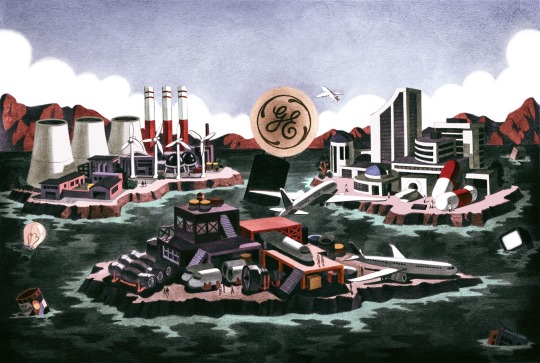
Illustration By Antoine Maillard
AN EMPIRE DIVIDED! The Inside Story of How GE CEO Larry Culp Dismantled a 131-Year-Old American Giant.
— By Brooke Sutherland and Ryan Beene | March 20, 2024 | Businessweek | The Big Take
Big sheets of white paper line the perimeter of a meeting room at the General Electric Co. factory in Beavercreek, Ohio. Each sheet is scribbled on with markers and covered with neon Post-it notes outlining the steps needed to produce the tubes and ducts that will eventually be assembled into a jet engine.
The vibe is more elementary school science fair than American industrial icon. But the simplicity is the point. Determining the layout for the Beavercreek facility was tricky: The revamped plant opened last year, combining components of production that had previously been spread out across eight different sites. To figure out the best setup, plant leaders built a replica of furnaces, tube benders and welding booths out of cardboard boxes. That visual, along with the Post-it notes describing production steps such as “brazing,” “bending” and “trimming,” makes it easier to identify and root out manufacturing inefficiencies. The exercise also helps show visiting GE executives how the whole thing works.

Featured in Bloomberg Businessweek, March 25, 2024. Photo illustration: Todd St. John for Bloomberg Businessweek
About 250 managers from around the world have gathered here in the Cincinnati area, which will be the headquarters of GE Aerospace once the conglomerate completes its slow-moving breakup in early April. One stated goal of the executive retreat is to set a culture for the soon-to-be-standalone company. “Culture can’t be declared,” says Farah Borges, who oversees GE Aerospace’s assembly, test and maintenance operations. “You have to build it.” Some declaring is still apparently necessary, because the team spent the previous day at an event space a few miles away doing just that.
But under Chief Executive Officer Larry Culp, no leadership confab is complete without a gemba walk. Gemba in Japanese means “actual place,” as in the actual place where a product is made. It’s essentially a tour of operations with a heavy emphasis on Q&A with the factory staff. The practice is central to lean manufacturing, an influential operations philosophy developed by Toyota Motor Corp. that Culp has championed at GE.

Culp at the Beavercreek factory in February. Courtesy: General Electric
Factory floor visits aren’t a radical idea for an industrial company, but GE didn’t always do them this way. The company used to place more emphasis on polishing a PowerPoint presentation than on drilling into the details of manufacturing workflows, says Russell Stokes, the head of commercial jet engines and services, who’s been at GE for more than 25 years. Somewhere between the wrong-way financial bets that blew up in the 2008 economic crisis and a huge, disastrous acquisition of energy assets from Alstom SA in 2015, GE, with its persistent mindset that anyone with an MBA could run any business, forgot that it’s a manufacturer at heart.
When Culp became CEO in 2018, GE was far too big and complicated for its own good, and the company’s businesses weren’t bringing in enough money to support its sky-high debts. “We were at risk of not making payroll, in a manner of speaking,” he says. He managed to pay down more than $100 billion of the debt through a series of well-timed divestitures. He dismantled GE Capital, its investment arm, largely untangling the company from a financial albatross. And then, in 2021, he announced that GE—the quintessential American conglomerate, which at one point or another sold washing machines, credit cards, plastic resins and TV advertising slots for NBC’s Super Bowl broadcasts—was breaking up. None of those efforts would’ve been as successful, and perhaps wouldn’t have even been possible, if Culp hadn’t tightened up GE’s operations and turned key businesses into stable, cash-generating entities that could stand on their own.
Today, GE’s stock is near a seven-year high. GE HealthCare Technologies Inc., which split off in 2023, is up about 50% from its debut. The final piece is the electric-grid, gas-power and wind-turbine business, which will become its own standalone company called GE Vernova on April 2.
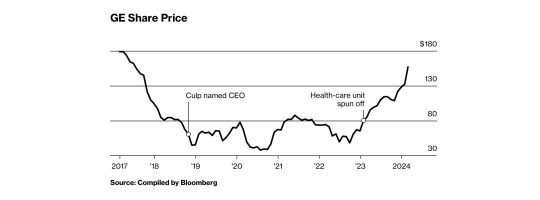
In one sense, Culp is restoring GE to its original identity as a maker of stuff. But he’s also the guy dismantling a monument to American capitalism. From its inception as an outlet for Thomas Edison to commercialize the lightbulb through the era of rapid globalization embodied by Jack Welch, GE practically swallowed entire industries. It loaned planes to companies and money to real estate developers; for a time it even owned a large chunk of Dreyer’s Grand Ice Cream. Most of that is gone now. Culp divested the aircraft leasing arm, biopharmaceutical assets and the remnants of GE’s oil and gas operations and saw through sales of its locomotive and lightbulb units. Even the GE name is on loan. GE appliances are made and sold by China’s Haier Smart Home Co. The new GE will just be a manufacturer of jet engines, essentially, with a few random money pits left over from the old conglomerate, like insurance for elder care and a Polish mortgage business. “We constantly debated what the right structure was,” says Ed Garden, a GE board member since 2017. “But the first order of business was fixing the underlying businesses.”
On the gemba walk, Culp and his aerospace deputies stop to meet with the plant’s lean manufacturing leader, Cem Salahifar, who launches into an overview of the factory’s operations. He describes the facility’s transition from a single, giant furnace—known in manufacturing parlance as a monument—to a bunch of smaller ones spread out around the factory floor. This eliminates the need for employees to shuttle components back and forth and stand around waiting for the heating process to complete. Turnaround times for this part of the production process dropped to 30 minutes from four hours. Culp interjects: The team should appreciate how meaningful this change was, he says, for improving efficiency. He then asks them to find ways to rethink the monuments in their own factories. “We like to tear down monuments,” Culp says.
General Electric Through the Years
The historic American company amassed a sprawling portfolio that at one time or another included locomotives, washing machines, insurance, lightbulbs, MRI machines, credit cards, real estate and the television network NBC.
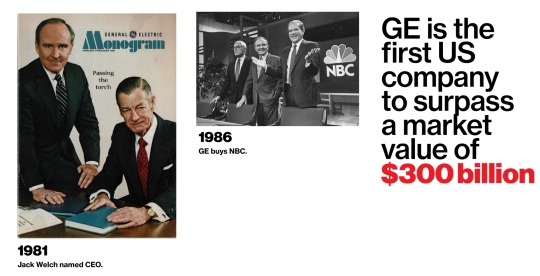
To be CEO of GE is to be compared with the late Jack Welch. For most of his two-decade reign, Welch made the company bigger, more valuable and more profitable. But the sun began to set on the age of the conglomerate by the time he retired in 2001, and soon other industrial giants were breaking up. Post-Welch CEOs at GE found themselves trying to explain why it made sense to be big for the sake of being big. Jeff Immelt, Welch’s handpicked successor, talked up the benefits of the “GE Store,” a shared repository of technological tools that the whole company could pull off the shelf. In reality, there was no good reason why one company needed to sell MRI machines, jet engines and wind turbines. Even worse, GE’s voluminous sprawl left too many places for problems to hide.


Left: A Leap engine at the Lafayette Engine Facility in Indiana. Photographer: Christopher Payne/Esto/Redux Right: A jet engine test operation. Photographer: Christopher Payne/Esto/Redux
One of the biggest problems was GE Capital, which helped fuel stock growth during the Welch years but proved to be a time bomb. GE had loaded up on debt to support its ventures in corporate lending, real estate, credit cards, mortgages and insurance. When the economic crisis arrived in 2008, GE Capital had more than $500 billion in assets and almost as much debt, which made it the largest financial company in the US that wasn’t technically a bank. As customers worldwide defaulted on loan payments and investors lost their appetite for risk, GE turned to Warren Buffett and the federal government for financial support. Immelt cut GE’s dividend for the first time since the Great Depression. He later sold off huge chunks of GE Capital, but it continued to haunt his successor, John Flannery, who in 2018 disclosed a $15 billion hole in a long-term-care insurance business Immelt had been unable to fully get rid of. The timing couldn’t have been worse: Flannery had cut the dividend two months earlier, to some shareholders’ dismay, and with the gas-power business in a slump and fewer GE Capital assets, there just wasn’t enough money from its operations to keep handing out such generous payments to investors.
GE’s stock was in free fall in 2018, and Flannery overhauled the board. One of the new directors was Culp. A graduate of and former senior lecturer at Harvard Business School, he’d previously been the CEO of Danaher Corp., a onetime industrial conglomerate in its own right that’s idolized by investors for its operational rigor. (Danaher eventually broke up, starting in 2016 with the spinoff of the industrial products company Fortive Corp., shortly after Culp left.)
Culp’s Message: “Everybody Around The Boardroom, Don’t Panic”
Flannery announced a plan to spin off GE’s health-care business in June 2018, but such a wholesale breakup quickly became untenable. The company couldn’t afford it: The remaining operations wouldn’t have generated enough cash to allow GE to pay off its mountain of debt. “We could not spin health care without putting everything fundamentally at risk,” Culp says.
GE’s directors asked Culp if he wanted to run the company. He turned them down—twice, he says—but an August 2018 visit to GE’s gas-power operations in Atlanta began to change his mind. The place was a mess, he tells Bloomberg Businessweek. “We were managing the business in a way that was probably 180 degrees from the way we ran things at Danaher,” he says. But Culp saw a path to fix GE’s operations. His message: “Everybody around the boardroom, don’t panic.”
GE directors offer a bingo card’s worth of MBA-speak to describe how rough the situation was. Tom Horton, former CEO of American Airlines, says he and Culp were both “eyes wide open” when they joined the board together in 2018: “Once we got under the hood, the challenges were more substantial than maybe we anticipated.”

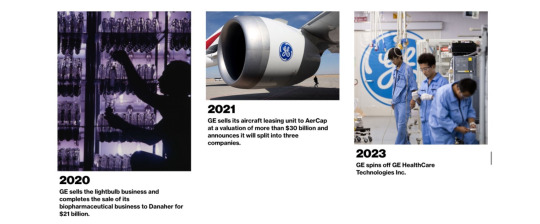
Two months after his visit to Atlanta, Culp was named CEO. In short order, he slashed the dividend to $0.01 a share and killed the plan to spin off health care. Instead, Culp brokered a deal to sell GE’s biopharmaceutical unit to his former employer Danaher. GE received $21 billion in cash for the business, which makes equipment and materials used to manufacture drugs, and offloaded $400 million in pension obligations to Danaher. The transaction was completed in March 2020, about three weeks after the onset of the Covid-19 pandemic brought air travel to a halt, creating an existential challenge for the company’s jet engine business. “I don’t know what would have happened if we hadn’t closed that deal,” Culp says.
GE directors thought the pandemic had made Culp’s job harder, and they wanted to give their CEO another reason to stick with it. In August 2020, the board altered the terms of Culp’s compensation package to give him more time to reach performance targets for a one-time stock bonus and make it meaningfully easier for him to have access to the top payout of about $230 million. Shareholders representing a majority of voting stock opposed the pay deal, but their vote was nonbinding, and the board had already approved the changes anyway. Culp accessed the top tier of the equity grant in July 2023, and the shares will vest next year unless he retires before then. (GE later curbed other aspects of Culp’s compensation.) “We were securing Larry’s leadership for a longer period of time, and that’s proven to be certainly in shareholders’ interest,” Horton says.
There are parallels between Culp and Welch, a company legend who was also legendarily well-compensated. The underlying principles of the lean manufacturing philosophy Culp preaches aren’t all that different from Welch’s cult of Six Sigma, another corporate dogma focused on measuring the rate of operational defects and eliminating inefficiencies. But the two are otherwise very different. Welch’s habit of ranking employees by performance and summarily firing the bottom 10% created a culture of mistrust. Employees who survived layoffs started to think they were the smartest people in the industry, a mentality that persisted after Welch retired and GE began to fade.
Culp has been programming a new mantra into his subordinates, adapted from his time at Danaher: We’re not perfect. “You’ll have some home runs, but you don’t need them every day,” says Jim Lico, who worked for Culp at Danaher and is now president and CEO of Fortive. “No one is perfect.” That kind of talk might’ve gotten a Welch-era executive fired, but it’s part of Culp’s belief in continuous improvement that his team routinely parrots.
This often manifests with seemingly small changes that can make a big impact on productivity over time. In one instance, GE reduced the distance a part must travel around its plant in Greenville, South Carolina, by about 3 miles, says Scott Strazik, the CEO of the soon-to-be-spun-out energy business GE Vernova. Even something as small as reorganizing the toolboxes used by turbine repair technicians can make a big difference. “There’s a long way to go,” Strazik says. GE Aerospace is trying to get its many factories to coordinate more with one another and with the teams that handle contract reviews and other back-office tasks. That process isn’t “perfect,” even if it has improved, says Kayla Ciotti, materials and planning leader at GE Aerospace. “Ten years ago, we had brick walls. Five years ago, we had screen doors,” she says. “The door is open now. There’s no door.”
In contrast with the cutthroat culture at Welch’s GE, Culp’s employees will get some leeway if they do walk into walls. “That doesn’t mean that if you screw something up and you do it repeatedly, there isn’t responsibility to bear,” Culp says. “But a problem-solving culture is far more effective operationally than a finger-pointing culture.”
Brian Carlson remembers his first gemba walk with Culp. Carlson, who runs the 1.2-million-square-foot GE factory in Schenectady, New York, that makes power plant generators, watched Culp stop at one production line in 2019 to inspect a reel of copper wire, which workers fashion into long, braided slabs bent like hockey sticks at both ends. Known as stator bars, these parts are installed inside the guts of enormous generators, which can weigh more than 400 tons. Culp was checking the manufacturing date on a reel of wire. Dozens of reels were stacked on shelves and pallets at the station, burning cash as long as they sat unused. “Others had visited Schenectady before, but it wasn’t into that level of detail,” Carlson says. “When Larry Culp shows up and wants to see how long your material’s been sitting on the factory floor, that simple gesture really sets a tone.”

The foam model at the Schenectady factory. Courtesy: General Electric
After that visit, workers cleared out a large room that once housed office space near the factory’s entrance and spent months building a scale model of the entire factory from hand-cut pieces of white and green foam, which they carefully laid out on rows of folding tables. Placards hang overhead marking each section of the factory, the largest of which declares the purpose of this enormous diorama: “Take it to the model before you take it to the floor.”
The foam factory is now a hub of Schenectady’s operations. Factory staff simulate projects first in the room before testing them on the factory floor. This is part of what’s known inside GE as a kaizen event. Culp loves a good kaizen. The Japanese term means continuous improvement and is another tenet of lean manufacturing. It’s a method for problem-solving that Culp has pushed throughout the company, in which executives and hourly workers dedicate a week to improve a production process, such as the stator bars that caught his attention during his visit in 2019. The goal is to come up with a solution by Friday and have the new process in motion on Monday.
The old way of making stator bars involved moving parts by crane through a 26-step process that took about three months to complete. Each bar now moves on rollers through an eight-step process in as little as three weeks. And now there’s only enough copper wire on hand to sustain a single shift.
On an unusually warm day in late February, Carlson motions to an area on the stator bar line where more improvement is needed. They still use a crane to hoist bars over an active walkway that crosses through the assembly line. A fix is in the works. “See,” he says, “we’re not perfect yet.”
“We Do Not Intend, Let Me Be Clear, To Be All Things To All People”
By early 2021, Culp’s turnaround of GE was starting to take hold, but the company was still sitting on too much debt. A solution arrived that March, when AerCap Holdings NV agreed to acquire GE’s aircraft leasing unit. The deal would allow GE to pay off $30 billion it had borrowed, reducing its debt to the point where the company could realistically think about establishing three separate businesses—in aerospace, health care and energy—that investors would actually want to own.
Culp started mapping out a breakup plan and gave it a code name: Project Revere, inspired by a monument to American patriot Paul Revere near Culp’s home in Boston. He liked the history motif. As GE’s board deliberated a split-up, a defining moment came in a PowerPoint presentation. A slide illustrated the degree to which investors were avoiding the stock simply because it was a conglomerate. “When you just looked at the companies that folks who really wanted to bet on the energy transition or on commercial aerospace were invested in, it was not with us,” Culp says.
In November, a week after the AerCap deal closed, GE announced the spinoff plan. “Everyone felt the weight of that decision,” Culp says at GE Aerospace’s Learning Center in Evendale, Ohio, where visitors can tour a museum of the company’s aerospace achievements, starting with the first American jet engine.
A breakup was never the only option, but it was the best one. Although modern conglomerates do exist (Alphabet, Amazon, Microsoft), GE’s ye olde smokestack model wasn’t working anymore. Investors were getting burned by its bigness more often than they were getting rewarded. The conglomerate structure is especially limiting when it comes to spending money, says David Giroux, a portfolio manager and chief investment officer of T. Rowe Price Investment Management. Massive companies tend to make the wrong acquisitions and overpay for them.
One deal Culp didn’t do was to pay an acquirer to make GE’s insurance problem go away. “There were checks back in the dark days that we could have written that would have been akin to having people tear our eyeballs out,” Culp says. “But you never want to be on the other side of that sort of trade.” Although GE hasn’t done any new business in long-term-care insurance in almost two decades, it’s still paying off claims it agreed to back for other providers. It’s now closed the $15 billion insurance funding shortfall, and investors treat the appendage as more of a quirk than the crisis it was in 2018. Culp says he might get rid of the business someday. But he’s not in any rush.
After the breakup, GE Aerospace will have $25 billion of cash to spend on dividends, share buybacks and acquisitions—with the first two taking priority. Culp won’t say what kinds of deals GE Aerospace might do, only that he’ll look for complementary and easily digestible assets. “We do not intend, let me be clear, to be all things to all people,” he told investors in early March.
All of GE’s gemba walks and kaizens and the intense scrutiny of its manufacturing operations look especially prudent after a series of high-profile quality-control failures among its peers. RTX Corp. is recalling thousands of jet engines because of a manufacturing glitch; Siemens Energy AG sought help from the German government after defects in its wind turbines resulted in massive losses; and Boeing Co. can’t even deliver its 737 Max with all the bolts properly installed.
When there are three GEs, Culp hopes the old name still means something to investors. He says that’s one reason he took the job in the first place: “It’s GE.”
At the company’s off-site in Ohio, executives gathered at Carillon Historical Park in Dayton. It’s home to the Wright Brothers’ Wright Flyer III, the first practical airplane. This piece of aviation history sits next to Culp’s Cafe, which serves an All-American egg sandwich and coffee for $13. The cafe has nothing to do with GE’s CEO. It’s named after Charlotte Gilbert Culp, who founded a baked-goods business in 1902 as a young widow in Dayton. At that time, GE was still just an electrical company.
#Bloomberg#Businessweek#The Big Take#General Electric#GE | CEO | Larry Culp#Dismantling of GE#An Empire Divided
0 notes
Text

ReduxStock: Photo by Ed Alcock/MYOP/Redux of Rwandan President Paul Kagame in Bloomberg Businessweek - January 29, 2024 issue.
0 notes
Text
#bloomberg#businessweek#yilmazyildiz#global warming#global risks#global riskler#global ısınma#global riskler raporu#world economic forum#davos 2024#artificial intelligence#technology
1 note
·
View note
Text

Kim Kardashian’s Skims Isn’t the Only Celebrity Brand to Watch 👀 New illustration for @businessweek 📈 The Year Ahead issue 🌍 thanks @alberlaurentiv 🤝 Very fun to draw Dolly 🤠
#illustration#samtaylor#illustrator#sam taylor#cartoon#drawing#artists on tumblr#art#kim kardashian#skims#dolly parton#beyonce#gal gadot#businessweek#bw#bloomberg#editorial
1 note
·
View note
Photo

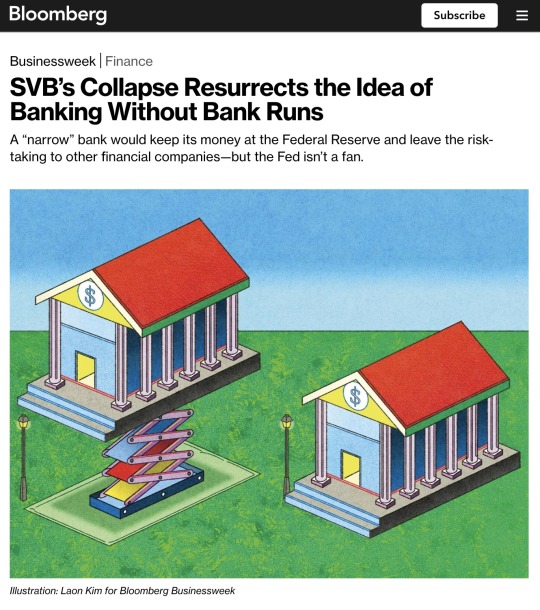
Bloomberg Businessweek
SVB’s Collapse Resurrects the Idea of Banking Without Bank Runs
1 note
·
View note
Text
Bloomberg Businessweek USA - May 01, 2023


Bloomberg Businessweek USA - May 01, 2023
English | 70 pages | pdf | 69.04 MB
Download from:
NitroFlare
FileFox
RapidGator
Read the full article
0 notes
Text


Did an illustration for Businessweek (@BW ), the article is about the prediction of future technology investment. Much thanks to AD Lee H. Wilson.
102 notes
·
View notes
Text

Illustration for Bloomberg, 2019
#bloomberg#steak#meat#illustration#editorialillustration#baptistevirot#virot#frenchillustration#businessweek
22 notes
·
View notes
Text
Race for AI Supremacy in Middle East Is Measured in Data Centers
One of the best places to view the Gulf states’ unfolding rivalry over artificial intelligence is inside an unmarked building in an industrial park near a golf course on the outskirts of Dubai. The windowless facility is cool and extraordinarily clean. Upon entering, guests step onto sticky blue floor mats designed to prevent stray sand particles from making their way inside. Like the scorching…
View On WordPress
#artificial intelligence#businessweek#California#cities#construction#EQUINIX INC#Government#infrastructure#Middle East#Saudi Arabia#Technology#United Arab Emirates
0 notes
Text
Journal Entry #68 - One Tough Cookie...Never Break Character, Flawless Integrity since the Year I was Born
JOURNAL ENTRY #68
Name: Manley M Collins
Social Security Number: 5 7 9 – * * – 6 5 4 1
Date of Birth: 06/21
Place of Birth: Washington, District of Columbia
Country of Birth: United States of America
Date: August 2, 2021
TOPIC: One Tough Cookie…Never Break Character, Flawless Integrity since the Year I was Born
Remembering the quote from my biological father, Mr. Manley Rochelle Nolen, "It does not matter where you are in the world." and my 2021 thought rebuttal, "You made a difference already the day you were born, life wants to see you do it."
I tried to get my money back regarding Lyft's CitiBike, but only was able to get a partial refund. I learn the new rules regarding credit and debit cards are put in place regarding 90 days or less to get refund and the responsibility is to work with the merchant first and second tries, then the bank or credit card company for the third try. There are most likely no refunds after sixty (60) days.
It was tax time again to file my Internal Revenue Service (IRS). I always file it paper because it does something to and overrides the another party that files as well.
I explored WeWork office location at 200 Berkeley St. I got the full tour plus they do mail and printing, too. They lacked storage lockers for the lower memberships. They did offer plenty for office space and open workspace. I explored based on the reason of potentially having another office job or desk job. I was ready, but the job offers never panned out.
I researched and purchased Warner Bros. Mortal Kombat 11 for my PC and smartphones, and watched the movie.
I saw a new book and skimmed through named, "The Power of Habit." Charles Duhigg (he went to Yale and Harvard). I never purchased the book because if you read through my blogs and see how I tried to be apart of them, the ivy leagues did not let me in so I began disconnecting and stop supporting or throwing my money at the ivy leagues ecosystem. I cannot stop all of it, but the ones I can read or see the credentials.
Boston Housing Authority Zero Income Statement validity.
I met with Crunch Fitness Regional GX Manager to possibly teaching there and the new locations. The Regional GX Manager gave the encouragement to get NASM AFAA Group Fitness Instructor certification. I renewed my membership with Planet Fitness, but added Crunch Fitness because of the ability to bodybuild or powerlift with higher weights and group fitness classes. The Regional GX Manager stated Crunch did not accept IFTA certificates.
I took advantage of the Planet Fitness's Rockbot. The staff and I had fun liking and disliking each other's song played. I went through almost the entire catalog of songs, especially holiday themed stuff and Sunday/Saturday had the gospel. Every Massachusetts Planet Fitness knew I was in the building when I came in with Kelis 'Milkshake', Megan Thee Stallion 'Body', Justin Bieber 'Yummy', Drake 'Sticky', Shakira 'Waka Waka', or Martin Solveig '+1', 'Do It Right' and 'Places'
When Walmart is unavailable, of course, I go to the local Target in Boston or Cambridge. CVS Pharmacy always get me with the coupons in email and on the app.
I had to temporarily serve as a process server for Defendants in lawsuits. Cook County Sheriff's office plus ProofServe helped served the Chicago area of Defendants. I did like the electronic automation system. ProofServe also helped served the Boston area of Defendants. ProofServe was darn sure cheaper than ABC Legal, which tried have you make a mortgage or car payment to have someone served, thus maxing out my DiscoverCard.
I had a dental appointment with Trinity Dental, but from the dental exam I could not get my teeth cleaning because of long-term infections, but had really good tooth pulled (extracted) for one infection and still not teeth cleaned. I was referred to a specialist for dental work I did not want to examine how get the other long-term infection (root canal).
Therapy and Psychiatrist with Arbour Counseling Services topics were
(Previous Journal topics - I just was repeating them to new people verbally)
Something changed Sunday, July 26, 2021 - relaxed and released feeling
Energy up
Remembered South Carolina dietary needs
Email communications
Fitness up - meaning running for 1.5 hours and upping speeds
Negative energy all week
Relationship closure
Calculating years since last relationship
Money
New York and Illinois
Barnes and Noble Boston - Fiction largest section
Spoke with a long time recruiter - Teksystems
Email clean out and Defense Department attempting to recruit for a return
Realizing with Crunch fitness scale confirming with clinic that I am overweight
Boston Copley Square library computers go down or offline.
Almost done with 2019.
Recruiters calling for opportunities
Good week
Discovered what glucose numbers look like without fasting
Walmart errand and got so much more stuff
Walking 11-20 miles per day
Laundromat closed
Adjustment to new Caplyta medication - dizziness, nausea, little panic attack, body temperature/libido rose, then sedation.
Still able to function.
Mellow emotions
Discovered the inactive online policy drives -freeze files and delete the storage after two years of inactivity. Same policy for email.
All this schizophrenic activity makes me upset and angry.
AT&T, Verizon, Google, and Flickr are some companies at a reasonable price makes sense for appropriate storage and use.
The Power of Habit - Charles Duhigg (went to Yale and Harvard) - is a turn off.
Victim, Supporter, Helper, Doer position is becoming annoying.
Loss of shift/job role from Federal Express for business reasons and because of extended leave.
Sexual life - parents have children, then start messing around, then get HIV/AIDS as a penalty…not a scientific statement, but based on meeting parents with children who have divorced or separated.
MGH Psychiatrist starts suggesting trying for third time in obtaining Social Security.
Chicago lawsuit
Thinking of ways to give the money back from the source it comes from
American Psychological Association webinar
Artificial Intelligence - Siri and Google Assistant
Federal Express
Harvard Business Review
Fighting for me - DOD and Federal Express
Promising future in the gym and sports world - I have never thought being a sports agent.
Cities and States
Laws, Rules, and Reality
Experienced and educated out the technology world.
Recruiters only fought to put in position and never gave feedback at the time of release for self-improvement.
New recruitment websites for freelancers or post-pandemic world
Cussing or using foul language more
Commencement no cheers - happy feeling
Reading Fortune magazine
Walgreens Boots Alliance CEO black woman Rosalind Brewer
To be a Fortune 500 CEO, you have to know someone or come up through the ranks.
Reading Bloomberg Businessweek
October 11, 2021 issue
secret Disney article to the rear of the magazine made me laugh hysterically on Sunday
MGH Psychiatrist Thoughts:
Do I have any thoughts on running for Mayor or President of the United States?
Obama, Kamala, and African-American/minority leaders are paving the way and making it more realistic. I know I have the skills and talent to do the position, but to make it real for me - for Mayor, I need one (1) million solid supports and voters or 70% of the entire voting rolls, plus 1 million dollars to run so that is $1.00 per person. For Governor, I need 70% of the entire voting rolls and $10.00 per voter. For President, I need solid 100 million voters to assure the win and $100 million dollars to start fundraising, which is $1.00 per person. This would make it realistic for me in The United States of America. I need my education debt paid for because I cannot or plan to go to Harvard University in getting more debt.
Otherwise, my realistic plans is my reality to do France and rise through the ranks to the Elyees Palace with family and all. I am not dumb, but only try once. France is my current focus. I can let go my rage and anger against America or the emotions created from life experiences.
After seeing candidates go into debt for position, I will never do.
Other Topics from Summer and Fall of 2021:
With the current set of lawsuits, I started requesting audits of the cases.
My University of Phoenix commencement card came in the United States Postal Service mail. When I got to Atlanta and saw the jumbotron, the card indicates how to introduce me on stage. It was impressive. I went to the Sanctuary nightclub at 3209 Paces Ferry Place NW, Atlanta, GA. I did not make it to MJQ Concourse club. I went to Atlanta Public Library and use their computers. I had a new Atlanta hairstylist who did my hair. My commencement was livestream via YouTube…so impressive. Check my photoblogs for the actual pictures. I did celebrate with my Rho Kappa Lambda Chapter of Alpha Phi Alpha fraternity brothers during commencement weekend.
MGH Psychiatrist starts suggesting trying for third time in obtaining Social Security.
New blogging sites, such as Reddit, Medium, and Mastodon, but they did not like repeat or already published information. They are expecting blogs or writing with a twist, creative writing, or alternative truth.
I earned Busuu McGraw Hill French level certificates.
I researched for The Hartford Small Business Insurance again for group fitness and personal training insurance, and Small Business coverage too.
UberEats and DoorDash increases deliveries because students were returning and peaked because I hibernate during the winter. During the winter, there are no deliveries.
I began my research in VISAs to the European Union and how to make the most of 90 days to make it a one-way trip.
Apple impressed me with AppleCare program for repairing the front glass of the iPhone. Belkin Invisiglass was very good, but was taking on a lot of beating. Belkin replaced one out of four registered purchases. It was not cheap protecting the Apple iPhone.
I participated with Snow Companies and Gilead Advisory Board.
I did order Walmart using DoorDash.
I used UberEats to deliver my meals.
I signed up for a Cannabis Delivery Driver, but they did not allow footwalkers or bike so you had to have a vehicle with insurance.
I had to renew my Massachusetts SNAP or Food Stamps with Massachusetts Department of Transition Assistance.
I had to renew my MassHealth (BMC Community Health Plan) with Massachusetts Department of Transition Assistance.
I donated to Massachusetts General Hospital, St. Francis House, and Pine Street Inn.
I did not win the Massachusetts VaxMillions giveaway, but registered.
I had my second Federal Express Fitness for Duty Evaluation.
I participated with Centers for Disease Control VAERS and vaccine safety programs in giving feedback on the COVID-19 vaccination process.
Other organizations, such as St. Francis House, Pine Street Inn, Crunch Fitness, and Planet Fitness, tried to continue the assaults or touching after Federal Express and BPHC Southampton. Stay on lookout for 2022 posts on how I am handling those organizations (South Carolina, Georgia, and Washington, DC know what I do).
#manley marvell collins#massachusetts#boston#south carolina#georgia#university of phoenix#commencement#planet fitness#crunch fitness#cdc#vaers#masshealth#snap#food stamps#cannabis#fortune#businessweek#federal express#southampton#bphc#atlanta#therapy#mental health
0 notes
Text
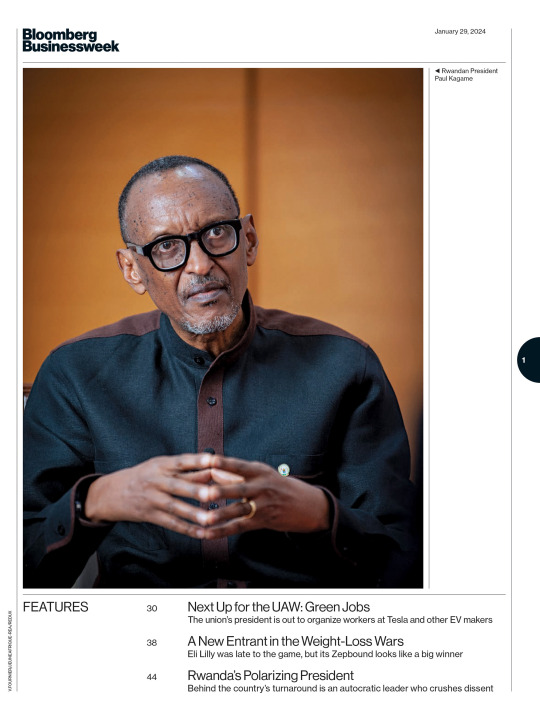
ReduxStock: Photo by V. Fournier/JeuneAfrique/REA/Redux of Rwandan President Paul Kagame in Bloomberg Businessweek - January 29, 2024 issue.
0 notes
